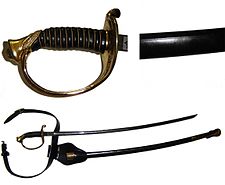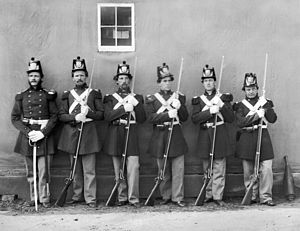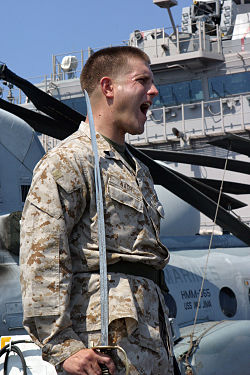- Marine non-commissioned officers' sword, 1859-present
-
USMC Model 1859 NCO Sword 
Type Sword Place of origin USA Service history In service USMC Used by Noncommissioned officers Wars Mid-19th and early-20th centuries Production history Designer Modeled on U.S. Army M1850 foot officers’ sword Designed Introduced 1859, notable design changes 1875, 1918 Manufacturer Horstmann, Ames, various others Produced 1859 to present Number built Undetermined Variants Unetched blades until 1875, wide blades until 1918 Specifications Length 34"-36" commonly Blade length 28"-30" commonly Blade type Saber, slightly curved, single-edged with false edge Hilt type Cast-brass hilt, leather-wrapped grip Scabbard/sheath Black-leather scabbard, two brass mounts, frog stud Contents
Description
The sword adopted in 1859 and subsequently carried by noncommissioned officers (NCOs) of the United States Marine Corps is patterned after the United States Army’s foot officers’ sword of 1850, with minor differences. Marine NCO swords feature a cast-brass hilt with a half-basket guard; leather-wrapped grip bound with twisted brass wire; a slightly curved, single-edged blade with a wide central fuller and short false edge; and a black-leather scabbard with two brass mounts, including an upper mount with a stud for carrying in a leather belt frog, and a brass tip with drag.
History & development
U.S. Marine officers and NCOs have carried swords since the American Revolutionary War. During the earliest years, the swords worn by Marine NCOs are believed to have been based on Army patterns, though not necessarily the exact swords used by Army NCOs. By approximately the mid-1820s, however, Marine NCOs began wearing distinctive short sabres with cast brass eaglehead hilts and curved blades. About this same time, in 1826, Marine Corps officers also began wearing a distinctive new sword of the Mameluke style, similar to those worn today.
 Five U.S. Marines with fixed bayonets. Their NCO displays his M1859 sword. Navy Yard, Washington, D.C., April 1864.
Five U.S. Marines with fixed bayonets. Their NCO displays his M1859 sword. Navy Yard, Washington, D.C., April 1864.
In 1859, a completely new sword pattern was introduced for Marine Corps officers, who were instructed to wear the same sword then worn by Army foot officers since 1850. In addition, in 1859 a similar sword was authorized for wear by Marine NCOs, so that the swords worn by Marine officers and NCOs appeared to share very nearly the same pattern and characteristics. The Marine NCO version, though similar to that worn by Marine officers, had several differences. Among the most noticeable, NCO swords had plain brass hilts and scabbard mounts, whereas officers’ hilts and scabbard mounts normally were gilt. In addition, the grips on NCO swords were wrapped with leather, whereas those for officers were usually covered with sharkskin. Finally, NCO scabbards had only two scabbard mounts, consisting of a top mount with frog stud and a scabbard tip, whereas officers’ scabbards bore three mounts, including upper and middle mounts fitted with carrying rings.
The sword worn by Marine NCOs since 1859 was also carried throughout the American Civil War. With only slight modifications since that time, it has maintained its distinctive and traditional appearance. Even though the Navy Officer Sword is older, 1852, it was discontinued until reauthorized during the (1900s) the M1859 Marine NCO sword is the oldest weapon in continued (unbroken) service still in U.S. inventory.
Variations
 Marine using an NCO Sword with the MCCUU.
Marine using an NCO Sword with the MCCUU.
Model 1859 Marine NCO swords initially were equipped with heavy, wide blades similar in shape and weight to those typically used on standard Army M1850 foot officers’ swords. Unlike the Army officers’ blades, however, the blades on early Marine NCO swords were polished bright but not etched. The familiar etched designs on Marine NCO swords were authorized in 1875 regulations, and they have been a standard feature of Marine NCO swords ever since. That same year, in 1875, Marine officers once again were permitted to wear their traditional Mameluke swords, which had been discontinued since 1859. At some point after 1875, Marine senior staff NCOs wore swords fitted with carrying rings, for attachment to sword belt slings, as opposed to traditional attachment by a stud in a sliding frog; this practice ceased during WWII and was not continued. The only subsequent change significantly affecting Marine NCO swords was in 1918, when uniform regulations specified that blade width be reduced to the narrow dimensions seen today.
The M1859 NCO sword continues service today as the Marine Corps drill and ceremonial sword. In the Marine Corps the sword's use is restricted by regulation to ceremonial occasions by an NCO or Staff NCO in command of troops under arms.
See also
- Mameluke sword
- Model 1840 Army Noncommissioned Officers' Sword
- U.S. Marine Corps swords
- U.S. regulation swords
References
LtCol (Ret.) Cureton, Charles H., USMC. “Early Marine Corps Swords,” The Bulletin of the American Society of Arms Collectors, No. 93, 2006, pp. 110–133.
Crouch, Howard R. Historic American Swords. Fairfax, VA: SCS Publications, 1999, pp. 99–105.
Peterson, Harold L. The American Sword 1775-1945. Philadelphia: Ray Riling Arms Books Co., 1970, pp. 57–58.
USMC Essential Subjects, Dept. of Defense Legacy Resource Management Program, ISBN 0-9675123-6-0
Guidebook For Marines, Dept. of Defense Legacy Resource Management Program, ISBN 0-940328-07-0
Simmons & Moskin, The Marines, 1998, ISBN 0-88363-198-9, pp. 138–139
NAVMC 2691, Marine Corps Drill and Ceremonies Manual, January 1999
External links
- Current USMC M1859 NCO sword with accouterments
- James Morrow, The Uniforms, Weapons & Accouterments of the United States Marine Corps during the American Civil War
Categories:- Swords of the United States
- United States Marine Corps equipment
- United States Marine Corps lore and symbols
- American Civil War weapons
Wikimedia Foundation. 2010.

